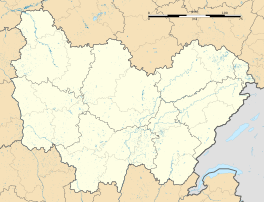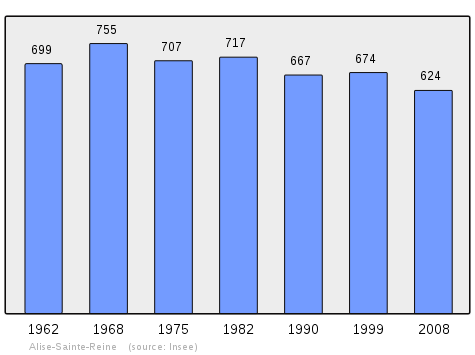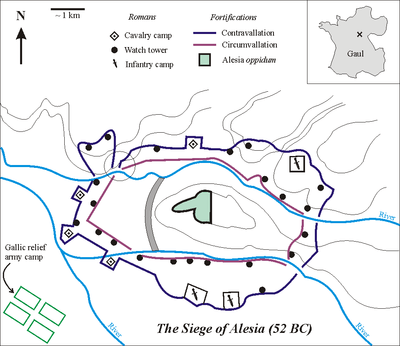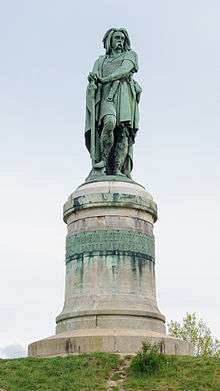Alise-Sainte-Reine
| Alise-Sainte-Reine | |
|---|---|
 | |
 Alise-Sainte-Reine | |
|
Location within Bourgogne-Franche-Comté region  Alise-Sainte-Reine | |
| Coordinates: 47°32′15″N 4°29′27″E / 47.5375°N 4.4908°ECoordinates: 47°32′15″N 4°29′27″E / 47.5375°N 4.4908°E | |
| Country | France |
| Region | Bourgogne-Franche-Comté |
| Department | Côte-d'Or |
| Arrondissement | Montbard |
| Canton | Venarey-les-Laumes |
| Intercommunality | Pays d'Alésia et de la Seine |
| Government | |
| • Mayor (2008–2020) | Laurent Maillard |
| Area1 | 3.83 km2 (1.48 sq mi) |
| Population (2009)2 | 624 |
| • Density | 160/km2 (420/sq mi) |
| Time zone | CET (UTC+1) |
| • Summer (DST) | CEST (UTC+2) |
| INSEE/Postal code | 21008 / 21150 |
| Elevation |
237–407 m (778–1,335 ft) (avg. 344 m or 1,129 ft) |
|
1 French Land Register data, which excludes lakes, ponds, glaciers > 1 km² (0.386 sq mi or 247 acres) and river estuaries. 2 Population without double counting: residents of multiple communes (e.g., students and military personnel) only counted once. | |
Alise-Sainte-Reine (Alise-Ste-Reine) is a commune in the Côte-d'Or department in the Bourgogne-Franche-Comté region of eastern France.
The inhabitants of the commune are known as Alisiens or Alisiennes.[1]
Geography
Alise-Sainte-Reine is located some 17 km south-east of Montbard and 50 km north-west of Dijon. The D905 from Venarey-les-Laumes to Posanges in the south passes through the western part of the commune. Access to the village however is on the D103, D103J, and D103T from Venaray-les-Laumes in the west which continues east to join the D10 road. Apart from the village the commune consists of farmland with some forest and a horse racing track in the west.[2]
The Ozeraine river forms most of the southern border of the commune and flows west to join the Brenne west of the commune.[2]
Neighbouring communes and villages[2]
 |
Ménétreux-le-Pitois | Grésigny-Sainte-Reine |  | |
| Venarey-les-Laumes | |
Darcey | ||
| ||||
| | ||||
| Pouillenay | Flavigny-sur-Ozerain |
Etymology
Because of its identification with Alesia the origin of the name of Alise-Sainte-Reine has been the subject of numerous studies. Several ideas have been proposed for a root of *alis and three proposals have attracted the attention of linguists and toponymists:[3]
These points were confirmed by Jacques Lacroix[4] in his study of the god of Alise: Alisanos.[5]
Research on alisier remains largely unfinished despite numerous attempts to develop the subject.[6][7]
The theme of the oronyme *alis or *ales meaning "rocky height" is the one that is currently most frequently put forward to explain the name of Alesia. It is from an Indo-European root *palis or *pales, the initial [p] became silent in Celtic, while on the contrary it remains in Latin place names such as Palatinus (Palatine Hill) for example. In Germanic the Indo-European [p] was mute [f] which gives *falisa in lower Old Frankish, felisa in Old High German or the German Fels meaning "rock".[8][9][10][11] A number of researchers also believe that the term may be suitable for a site in Alise-Sainte-Reine that has cliffs.
The explanation of a hydronym was mentioned early - in 1901 Camille Jullian said that the name of Alise derived from the spring in the heart of the village and which was very famous until the early 20th century.[12] It recurred in 1908 by breaking the radical *Alis into two themes AL + IS.[13]
In 1956 Paul Lebel did not resume this juxtaposition of the two hydronymic themes, he proposed instead for some rivers the prototype *alisa from the post-Celtic period, which is why in the case of Alesia, he ultimately opted for the oronym.[14]
In 1990 the study of the etymology of the name of Alesia was taken over by Marianne Mulon.[15] She wrote that the oronymic and the hydronymic tracks[16] were both "reasonable" proposals. The same year Ernest Nègre in his General toponymy of France, vol 1, explained the name of Alise-Sainte-Reine as pre-Celtic *alis + Gallic Suffix -ia and he indicated that it is a derivative from a designation of a spring.[17] In 1995 the historian Francis Lassus and linguist Gerard Taverdet annotate the study by Ernest Nègre stating that his explanation by hydronym is legitimate because of the thermal spring present at Alise.[18] In 2007 Gerard Taverdet stated that this spring has been the subject of numerous pilgrimages while being exploited for therapy.[19]
In 2010 Stephane Gendron, another Toponymist, posed the question: is it from the root *ales designating a mountain or the root *alis designating the spring? He adds, however, that the village has a mineral source and a sanctuary with a Gallic bathhouse with a therapeutic function.[20][21]
The healing waters site were undoubtedly famous since Celtic times. In the modern era the trade in mineral water from Alise went beyond the borders of Burgundy and even extended to Europe which lasted until the early 20th century.[22] The sanctuary was very large and it was dedicated to Apollo Moritasgus.[23][24] Jacques Lacroix said that this deity was associated with the healing waters with the first part of its name Mori- designating the sea or water as in are-morica (Armorique) or in the maritime tribe of the Morini.[25]
During the revolutionary period of the National Convention (1792-1795), the commune bore the names of Alise and Petite-Alise.[26]
History
Alise is strongly reminiscent of Alesia and it is perhaps no coincidence since the town lies at the foot of Mont Auxois and the Gallic oppidum attested by excavations and a likely archaeological site, although still contested by some, of the ancient fortress defended by Vercingetorix.
- Sainte-Reine is directly derived from the name of the Christian martyr Sainte Reine who was beheaded at this place in 252 AD. and who is the commune's patron saint.
The common symbol to represent the town is the statue of Vercingetorix erected by the orders of Napoleon III to show the strength of Gaul.
The identification of Alesia with Alise
The identification of Alesia with Alise is based on a now considerable amount of archaeological and historical research:
- Alise is the oldest site identified with Alesia. The identification had already been made in the Carolingian period.
- There is no real inconsistency between Caesar's text and the site as long as it is understood that, in the first place, Caesar was addressing a Roman public who were a little anxious about topographical information for a site they would never see and, in the second place, that Caesar was writing a story destined to be valued according to a number of rules and rhetorical commonplaces.
- The text of Dion Cassius placing Alesia in Séquanes was written long after the siege and may be wrong: its value as a source cannot be placed above the text of Caesar or the text of Strabo, which placed Alesia closer to Arvernes. Although the remarks of Diodorus of Sicily on Alesia are not as late as Dion, their value should not be exaggerated and cannot fully guide a search. Didorus was concerned not only with the location of the site but also with its religious character.
- The oppidum on Mount Auxois at Alise first revealed Gallo-Roman constructions from after the battle. But its Gallic levels are now known to be contemporary with the Gallic Wars and have been so identified without any doubt.
- A Gallic inscription in Latin characters[27][28][29] from the Roman era is assuredly the name of the place: Alisiia, an identification of the Gallic form of the name with the Latin form Alesia, is explained by the phonology of the short vowels /e/ and /i/ in Gallic.[30][31]
- Excavations in the reign of Napoleon III identified clear traces of Roman siege works. Long criticized, their value has been confirmed by excavations in the 1990s by a Franco-German team. The Roman temporary fortifications that were found are consistent with Caesar's text, even if they show that Caesar sometimes generalized his descriptions. Excavations demonstrated the ability of the Romans to adapt their equipment to the terrain.
- Coins found in the 19th century were authenticated by recent scientific studies including those of Jean-Baptiste Colbert de Beaulieu and new discoveries made in the 1990s. The large number of Roman coins is easily explained by the presence of Caesar's legions. The great diversity of Gallic coins with significant Arvernian sets including coins of Vercingetorix, the Aedui and the Sequani, can only be explained by the presence of coalition troops.
- The discovery, during recent excavations in one of the Roman camps, of a sling shot with the name of Caesar's lieutenant Labienus, leaves no possible doubt that the fortification works are from Caesar's army and date from the Gallic War.
- The series of archaeological aerial photographs taken since 1959 show evidence of continuous lines of ditches corresponding to the military investments of the siege of Alesia.[32]
Given these facts, a consensus on the location of the battle has been reached by professional historians and archaeologists in France and abroad (where the controversy was not as great). However, associations and individuals continue to put forward alternative hypotheses.[33]
Administration
List of Successive Mayors[34]
| From | To | Name | Party | Position |
|---|---|---|---|---|
| ? | 1989 | Jacques Beauger | ||
| 1989 | 2008 | Jacques Barozet | DVG | |
| 2008 | 2020 | Laurent Maillard |
(Not all data is known)
Demography
In 2009 the commune had 624 inhabitants. The evolution of the number of inhabitants is known through the population censuses conducted in the commune since 1793. From the 21st century, a census of communes with fewer than 10,000 inhabitants is held every five years, unlike larger towns that have a sample survey every year.[Note 1]
| 1793 | 1800 | 1806 | 1821 | 1831 | 1836 | 1841 | 1846 | 1851 |
|---|---|---|---|---|---|---|---|---|
| 701 | 395 | 656 | 677 | 677 | 681 | 776 | 758 | 798 |
| 1856 | 1861 | 1866 | 1872 | 1876 | 1881 | 1886 | 1891 | 1896 |
|---|---|---|---|---|---|---|---|---|
| 741 | 734 | 735 | 707 | 757 | 734 | 703 | 698 | 642 |
| 1901 | 1906 | 1911 | 1921 | 1926 | 1931 | 1936 | 1946 | 1954 |
|---|---|---|---|---|---|---|---|---|
| 603 | 563 | 528 | 584 | 571 | 582 | 619 | 654 | 691 |
| 1962 | 1968 | 1975 | 1982 | 1990 | 1999 | 2006 | 2010 | - |
|---|---|---|---|---|---|---|---|---|
| 699 | 755 | 707 | 717 | 667 | 674 | - | 624 | - |
Sources : Ldh/EHESS/Cassini until 1962, INSEE database from 1968 (population without double counting and municipal population from 2006)

Culture and heritage
Civil heritage
The commune has a number of sites that are registered as historical monuments:
- The Vercingetorix Monument (1865)
 [35] was commissioned by Emperor Napoleon III from the sculptor Aimé Millet and installed in 1865 on Mont Auxois.
[35] was commissioned by Emperor Napoleon III from the sculptor Aimé Millet and installed in 1865 on Mont Auxois.
Picture Gallery of the Vercingetorix Monument
- The Sainte-Reine Hospital (1659).
 [36][37] The hospital contains a very large number of items which are registered as historical objects. For a complete list including links to descriptions (in French) click here and here.
[36][37] The hospital contains a very large number of items which are registered as historical objects. For a complete list including links to descriptions (in French) click here and here. - The Ancient site of Alesia (1st century).
 [38] The MuséoParc Alésia (on the site of the Battle of Alesia) has an oppidum and the remains of a Gallo-Roman city.[39] On 26 March 2012 the "interpretation centre" was opened to the public and aims to attract 150,000 visitors a year.[40]
[38] The MuséoParc Alésia (on the site of the Battle of Alesia) has an oppidum and the remains of a Gallo-Roman city.[39] On 26 March 2012 the "interpretation centre" was opened to the public and aims to attract 150,000 visitors a year.[40]
The Gallo-Roman site
The archaeological site of Alesia was not abandoned following the siege of Alesia. Recent excavations have unearthed the ruins of buildings that reflect the romanization of the site. There is a theatre to the north-west, which was a feature of Roman Gaul. It has a cavea in the shape of a semi-circle, in which the audience sat on wooden bleachers that have disappeared over time. The actors appeared in the orchestra. The capacity of the theatre is estimated to have been 5,000 seats, which is low compared to the theatre at Autun (20,000 seats). The circular wall of the cavea measures 81 metres. To the east of the theatre stood a temple which was commonly used in Gallo-Roman cities for both religion and entertainment. The cella of this temple stood on a podium similar to the Maison Carree in Nimes. Modest in size, it was opened up in accordance with the requirements of worship. Its facade had four columns of which nothing remains today. Archaeologists believe that this temple, which is surrounded by a wall built in the 2nd century AD, was dedicated to Taranis or Jupiter. The objects found at the site and kept at the Alesia Museum reflect the emergence of the cult of Cybele in the 3rd and 4th centuries.
Next to the temple a basilica served the political and judicial functions of the city. The Curia and courts held meetings in this type of building. The affairs of the city were also discussed in the public square: the forum. It was lined with shops and served as a meeting place for the city's inhabitants. There is a monument to the north of the forum that is said to be of Ucuetis, headquarters of the corporation of bronziers. It also served as a shrine to honour the gods Bergusia and Ucuetis.
Picture Gallery of the MuséoParc Alésia
-
View of the fortifications
-

Archeodrome at Alise-Sainte-Reine
-
-

-

-
-
-
-
-
Gallo-Roman divinities
-

Silver Drinking cup, 1st century
-

The cellar of a house
-

Map of fortifications built for Caesar at Alesia
-

-

Monument of Ucuetis
-

-

Ovens for bronzing
Religious heritage
The commune has several religious sites that are registered as historical monuments:
- The Croix Piroir Stone Cross (16th century)
 [41]
[41] - A Stone Cross and Altar at its base (1554)
 [42]
[42] - The Chapel and Fountain of Sainte-Reine (1498).
 [43] The chapel contains a very large number of items which are registered as historical objects. For a complete list including links to descriptions (in French) click here.
[43] The chapel contains a very large number of items which are registered as historical objects. For a complete list including links to descriptions (in French) click here.
- Other religious sites of interest
- The Church of Saint-Léger partly dates from as early as the 7th century.
-

The church exterior
-

The bell tower
-

The church interior
- A Temple at Croix-Saint-Charles,[44] has remains of columns, an octagonal sanctuary with its annexes and trenches indicating a surrounding wall, and unidentified quadrangular buildings.[45]
Cultural events
- Every Saturday and Sunday in August is a representation of the Mystery of Sainte Reine, a tradition that dates back to 866.
- The Festival of Nuits Peplum d'Alesia, a contemporary music festival in late July.
Notable people linked to the commune
- Sainte Reine, Christian martyr
- Félix Kir, a French Catholic priest, resistance fighter and politician was born in Alise-Sainte-Reine on 22 January 1876.
See also
- Communes of the Côte-d'Or department
- French wine
- Cantons of the Côte-d'Or department
- Arrondissements of the Côte-d'Or department
Bibliography
- André Berthier, André Wartelle, Alésia, Nouv. Éd. Latines, Paris, 1990 (French)
- Albert Dauzat, Gaston Deslandes, and Charles Rostaing, Etymological Dictionary of the names of rivers and mountains in France, Klincksieck, Paris, 1978. (French)
- Xavier Delamarre, Dictionary of the Gallic language: A linguistic approach to continental Old Celtic, Errance, Paris, 2003 (French)
- Camille Jullian, Notes on Gallo-roman Alésia, Review of Ancient Studies, 1901, p. 140. (French)
- Camille Jullian, The name of Alésia in pro Alésia 1, 1907-1908, p. 241. (French)
- Jacques Lacroix, pref. V. Kruta, Names of gallic Origin. Fighting Gaul, vol 1, Errance, Paris, 2003 (French)
- Jacques Lacroix, Names of Gallic Origin. The Gaul of Gods, vol 3, Errance, Paris, 2007. (French)
- Pierre-Yves Lambert, The Gallic language: linguistic description, commentary on selected inscriptions, Errance, Paris, 2003 (French)
- François Lassus and Gérard Taverdet, Place names of Franche-Comté. Introduction to the toponymy, Bonneton, 1995 (French)
- Paul Lebel, Principles and Methods of French hydronymy, Paris, 1956. (French)
- Joël Le Gall, Alésia. Archeology and history, Fayard, Paris, 1963 (French)
- Ernest Nègre, Alisia qui a dû désigner d'abord la source. The hydronym Alzonne in France, dans Otto Winkelmann, Maria Braisch, Festschrift für Johannes Hubschmid zum 65. Geburtstag. Beiträge zur allgemeines, indogermanischen and romanischen Sprachwissenschaft, Bern-Munich, Francke, 1982, p. 627. (German)
- Ernest Nègre, General Toponymy of France, vol, 1, Geneva, 1990 (French)
- Michel Reddé, Alésia. Archeology against Imagination, Paris, 2003 (French)
- Gérard Taverdet, Place names of Burgundy, Bonneton, 2007 (French)
External links
- MuseoParc Alésia
- Alise-Sainte-Reine on the old National Geographic Institute website (French)
- Alise-Sainte-Reine on Lion1906
- Alise-Sainte-Reine on Google Maps
- Alise-Sainte-Reine on Géoportail, National Geographic Institute (IGN) website (French)
- Alize and Ste Reyne on the 1750 Cassini Map
- Alise-Sainte-Reine on the INSEE website (French)
- INSEE (French)
Notes and references
Notes
- ↑ At the beginning of the 21st century, the methods of identification have been modified by law No. 2002-276 of 27 February 2002 , the so-called "law of local democracy" and in particular Title V "census operations" which allow, after a transitional period running from 2004 to 2008, the annual publication of the legal population of the different French administrative districts. For municipalities with a population greater than 10,000 inhabitants, a sample survey is conducted annually, the entire territory of these municipalities is taken into account at the end of the period of five years. The first "legal population" after 1999 under this new law came into force on 1 January 2009 and was based on the census of 2006.
References
- ↑ Inhabitants of Côte-d'Or (French)
- 1 2 3 Google Maps
- ↑ Albert Dauzat, Gaston Deslandes and Charles Rostaing, Etymological Dictionary of names of rivers and mountains in France, Klincksieck, Paris, 1978, pp. 5 and 8. (French)
- ↑ Jacques Lacroix, The Names of Gallic Origin. Gallic Gods, vol 3, Errance, Paris, 2007, pp. 37 and 38. (French)
- ↑ On the Theonym see also: Pierre-Yves Lambert The Gallic Language: Linguistic description, commentary on selected inscriptions, Errance, Paris, 2003, p. 105, pp. 137 and 138.
- ↑ François Lassus and Gérard Taverdet, Place names of Franche-Comté, introduction to their toponymy, Bonneton, 1995, p. 153: the authors highlighted, on the subject of the root *alisa, that the discussion is lively among linguists.
- ↑ Xavier Delamarre, Dictionary of the Gallic language: a linguistic approach to continental old-Celtic, Paris, Errance, 2003, p. 39. (French)
- ↑ Xavier Delamarre, op. cit, p. 39. (French)
- ↑ Gérard Taverdet, The placenames of Burgundy. Bonneton, 2007, p. 25. (French)
- ↑ Jacques Lacroix, preface by Venceslas Kruta, Names of Gallic Origin. Gallic Fighters, vol 1, Paris, Errance, 2003, p. 125. (French)
- ↑ Contribution by Marianne Mulon in André Berthier, André Wartelle, Alésia, Paris Nouv. Éd. Latines, 1990, p. 290. (French)
- ↑ Camille Jullian, Gallo-roman notes on Alésia in the Review of Ancient studies, 1901 p.140, also: The name of Alésia in pro Alésia 1, 1907-1908, pp. 241 and 242. (French)
- ↑ IS is a well known hydronymic theme which is notably found in the name of the Isère and the Oise.
- ↑ Paul Lebel, Principles and Methods of French hydronymy, Paris, 1956, 207-209 and p. 306 note 1.
- ↑ Marianne Mulon, Op. cit, pp. 289-292. (French)
- ↑ Theme also taken over by Xavier Delamarre, op. cit, p. 39: Alisia and its derivatives Alisontia, Alisincum etc., found in numerous toponyms and hydronyms in Gaul. (French)
- ↑ Ernest Nègre, General Toponymy of France, vol 1, Geneva, 1990 § 1016 root *Alis, 22-27. See also: Alisia as a designation of a spring. The hydronym Alzonne in France in Festschrift für Johannes hubschmid zum 65. Geburtstag, 1982, p. 627. (German)
- ↑ François Lassus and Gérard Taverdet, op. cit, p. 35. (French)
- ↑ Gérard Taverdet, op. cit, p. 24.
- ↑ Stephane Gendron, The names of the fortress in Gaul, in L'archéologue, No. 108, 2010, pp. 65 and 66. (French)
- ↑ The discovery of the sanctuary by Émile Espérandieu initially motivated by the desire to verify the hypothesis of the hydronym: E. Espérandieu, Note on the temple at the spring on Mount Auxois, CRAI, 53-7, 1909, pp. 498-506. (French)
- ↑ Michel Reddé, Alésia. Archeology against Imaginary, Paris, 2003, p. 73.
- ↑ Michel Reddé, op.cit, pp. 129 and 130. (French)
- ↑ Joël Le Gall, Alésia. Archeology and history, Paris, Fayard, 1963, p. 139. (French)
- ↑ Jacques Lacroix, The Gaul of Gods, op. cit, p. 97. (French)
- ↑ Communal Notice - Alise-Sainte-Reine, consulted on 31 July 2012. (French)
- ↑ CIL XIII, 2880. (French)
- ↑ M. Lejeune, The dedication of Martialis at Alise, REA, 81, 3-4, 1979, pp. 251-260. (French)
- ↑ RIG II, 1, pp. 147-155. (French)
- ↑ The Grammarian Consentius attested that the Gallic pronunciation e and i are similar. See P.-M. Duval, Gaul towards the middle of the 5th century, Paris, 1971, p. 774. (French)
- ↑ P.-Y. Lambert, The Gallic language, Paris, 2003, p. 43. with the example of Alesia. (French)
- ↑ Archaeology Archives, Alésia, How a Gallic oppidum is entered in history, No. 305, July–August 2005. A textbook case for aerial photography, pp. 46-55. (French)
- ↑ See: Battle of Alesia for a bibliography on the battle and the development on the controversy about its location.
- ↑ List of Mayors of France
- ↑ Ministry of Culture, Mérimée PA21000061 Vercingétorix Monument (French)
- ↑ Ministry of Culture, Mérimée PA00112056 Sainte-Reine Hospital (French)
- ↑ Ministry of Culture, Mérimée IA21000551 Sainte-Reine Hospital (French)

- ↑ Ministry of Culture, Mérimée PA00112053 Ancient site of Alésia (French)

- ↑ MuséoParc Alésia open from 2010-2011. (French)
- ↑ Opening of the MuséoParc, the battle of Alésia continues, Isabelle Chenu, 27 March 2012, RFI website (French).
- ↑ Ministry of Culture, Mérimée PA00112055 Croix Piroir Stone Cross (French)
- ↑ Ministry of Culture, Mérimée PA00112054 Stone Cross and Altar at its base (French)
- ↑ Ministry of Culture, Mérimée PA21000060 Chapel and Fountain of Sainte-Reine (French)
- ↑ Temple at Croix-Saint-Charles (French).
- ↑ Archéologia, No. 482, November 2010, p. 38. (French)
| Wikimedia Commons has media related to Alise-Sainte-Reine. |




